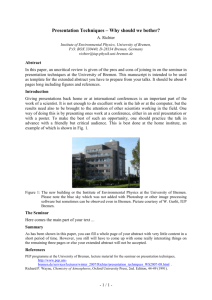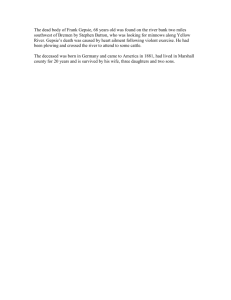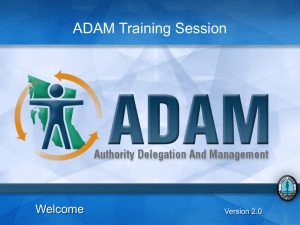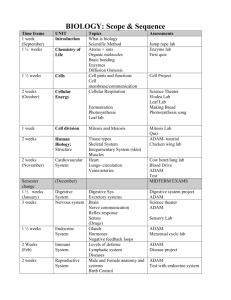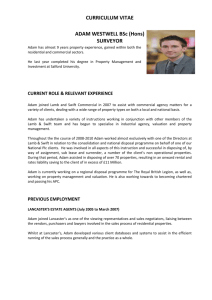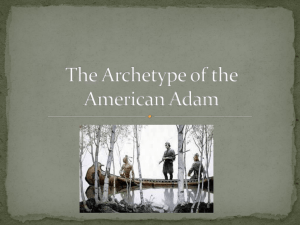CATHOLIC ENCYCLOPEDIA: Adam of Bremen
advertisement
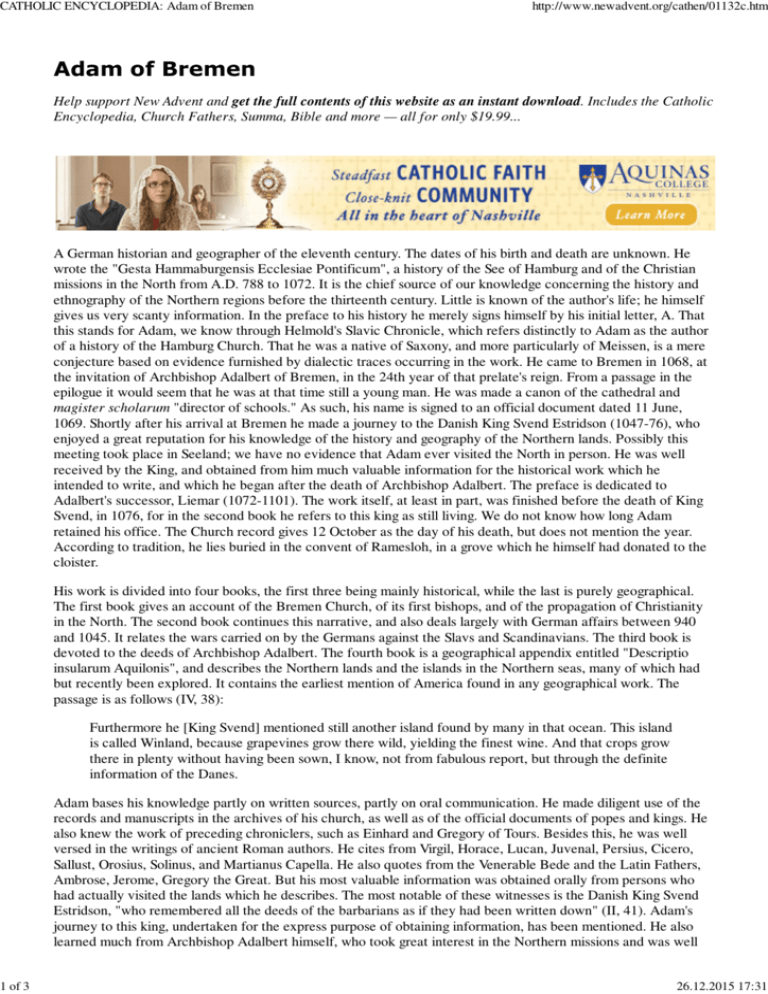
CATHOLIC ENCYCLOPEDIA: Adam of Bremen 1 of 3 http://www.newadvent.org/cathen/01132c.htm Adam of Bremen Help support New Advent and get the full contents of this website as an instant download. Includes the Catholic Encyclopedia, Church Fathers, Summa, Bible and more — all for only $19.99... A German historian and geographer of the eleventh century. The dates of his birth and death are unknown. He wrote the "Gesta Hammaburgensis Ecclesiae Pontificum", a history of the See of Hamburg and of the Christian missions in the North from A.D. 788 to 1072. It is the chief source of our knowledge concerning the history and ethnography of the Northern regions before the thirteenth century. Little is known of the author's life; he himself gives us very scanty information. In the preface to his history he merely signs himself by his initial letter, A. That this stands for Adam, we know through Helmold's Slavic Chronicle, which refers distinctly to Adam as the author of a history of the Hamburg Church. That he was a native of Saxony, and more particularly of Meissen, is a mere conjecture based on evidence furnished by dialectic traces occurring in the work. He came to Bremen in 1068, at the invitation of Archbishop Adalbert of Bremen, in the 24th year of that prelate's reign. From a passage in the epilogue it would seem that he was at that time still a young man. He was made a canon of the cathedral and magister scholarum "director of schools." As such, his name is signed to an official document dated 11 June, 1069. Shortly after his arrival at Bremen he made a journey to the Danish King Svend Estridson (1047-76), who enjoyed a great reputation for his knowledge of the history and geography of the Northern lands. Possibly this meeting took place in Seeland; we have no evidence that Adam ever visited the North in person. He was well received by the King, and obtained from him much valuable information for the historical work which he intended to write, and which he began after the death of Archbishop Adalbert. The preface is dedicated to Adalbert's successor, Liemar (1072-1101). The work itself, at least in part, was finished before the death of King Svend, in 1076, for in the second book he refers to this king as still living. We do not know how long Adam retained his office. The Church record gives 12 October as the day of his death, but does not mention the year. According to tradition, he lies buried in the convent of Ramesloh, in a grove which he himself had donated to the cloister. His work is divided into four books, the first three being mainly historical, while the last is purely geographical. The first book gives an account of the Bremen Church, of its first bishops, and of the propagation of Christianity in the North. The second book continues this narrative, and also deals largely with German affairs between 940 and 1045. It relates the wars carried on by the Germans against the Slavs and Scandinavians. The third book is devoted to the deeds of Archbishop Adalbert. The fourth book is a geographical appendix entitled "Descriptio insularum Aquilonis", and describes the Northern lands and the islands in the Northern seas, many of which had but recently been explored. It contains the earliest mention of America found in any geographical work. The passage is as follows (IV, 38): Furthermore he [King Svend] mentioned still another island found by many in that ocean. This island is called Winland, because grapevines grow there wild, yielding the finest wine. And that crops grow there in plenty without having been sown, I know, not from fabulous report, but through the definite information of the Danes. Adam bases his knowledge partly on written sources, partly on oral communication. He made diligent use of the records and manuscripts in the archives of his church, as well as of the official documents of popes and kings. He also knew the work of preceding chroniclers, such as Einhard and Gregory of Tours. Besides this, he was well versed in the writings of ancient Roman authors. He cites from Virgil, Horace, Lucan, Juvenal, Persius, Cicero, Sallust, Orosius, Solinus, and Martianus Capella. He also quotes from the Venerable Bede and the Latin Fathers, Ambrose, Jerome, Gregory the Great. But his most valuable information was obtained orally from persons who had actually visited the lands which he describes. The most notable of these witnesses is the Danish King Svend Estridson, "who remembered all the deeds of the barbarians as if they had been written down" (II, 41). Adam's journey to this king, undertaken for the express purpose of obtaining information, has been mentioned. He also learned much from Archbishop Adalbert himself, who took great interest in the Northern missions and was well 26.12.2015 17:31 CATHOLIC ENCYCLOPEDIA: Adam of Bremen 2 of 3 http://www.newadvent.org/cathen/01132c.htm informed about the lands where they were located. Much information was imparted to him also by the traders and missionaries who were continually passing through Bremen, the great centre for all travel to and from the North. Adam assures us repeatedly that he has taken great pains to make his account both truthful and accurate. "If I have not been able to write well", so he says in his epilogue, "I have at any rate written truthfully, using as authorities those who are best informed about the subject." As for the style in which the work is written, it cannot receive unqualified praise. It is closely modelled on Sallust, whole phrases and sentences from that author being often incorporated in Adam's work. Besides being obscure and difficult, his Latin shows a number of Germanisms, and is not free from positive grammatical errors. Of the manuscripts of the "Gesta" none are older than the thirteenth century, excepting one at Leyden, which, however, is very fragmentary. The best manuscript is at Vienna. The first edition was brought out by Andreas Severinus Velleius (Vedel), at Copenhagen, in 1579. Two subsequent editions were published at Hamburg, in 1595 and 1609 respectively, by Erpold Lindenbruch, a canon of the Hamburg Church; a fourth edition by Joachim Johannes Maderus appeared at Helmstadt in 1670; it is based on the preceding one. The best edition is that of Lappenberg in Pertz "Monum. Germ. Hist. Scriptores" (1846) VII, 267-293, reprinted in P.L., CXLVI, and reedited by Waitz in "Script. rer. Germ." (Hanover, 1876). The best translation is the German one by J. C. M. Laurent in "Geschichtschreiber der deutschen Vorzeit" (Berlin, 1850, ed. by Wattenbach; 2d edition, revised by Wattenbach Berlin, 1893). (See PRE-COLUMBIAN DISCOVERY OF AMERICA.) Comments 0 Comments Sort by Oldest Add a comment... Facebook Comments Plugin Sources Preface to LAPPENBERG'S ed. of Adam of Bremen. Also ASMUSSEN, De Fontibus Adami Bremensis (Kiel, 1834); BERNARD, De Adamo Bremensi Geographo (Paris, 1895); LÖNBORG, Adam of Bremen, och hans skildrina af Nordeuropas länder och folk (Upsala, 1877). About this page APA citation. Remy, A.F.J. (1907). Adam of Bremen. In The Catholic Encyclopedia. New York: Robert Appleton Company. Retrieved December 26, 2015 from New Advent: http://www.newadvent.org/cathen /01132c.htm MLA citation. Remy, Arthur F.J. "Adam of Bremen." The Catholic Encyclopedia. Vol. 1. New York: Robert Appleton Company, 1907. 26 Dec. 2015 <http://www.newadvent.org/cathen/01132c.htm>. Ecclesiastical approbation. Nihil Obstat. March 1, 1907. Remy Lafort, S.T.D., Censor. Imprimatur. +John Cardinal Farley, Archbishop of New York. Contact information. The editor of New Advent is Kevin Knight. My email address is webmaster at newadvent.org. Regrettably, I can't reply to every letter, but I greatly appreciate your feedback — especially 26.12.2015 17:31


